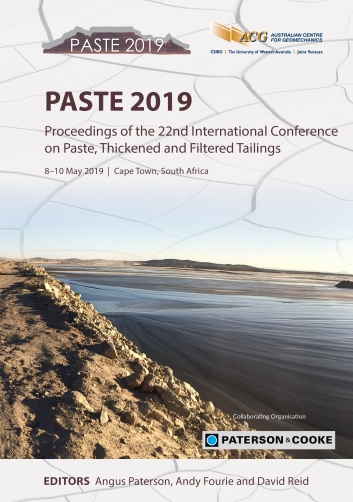Electrokinetic dewatering of mine tailings from hydrometallurgical processes

|
Authors: Shang, JQ; Xu, Y |
DOI https://doi.org/10.36487/ACG_rep/1910_18_Shang
Cite As:
Shang, JQ & Xu, Y 2019, 'Electrokinetic dewatering of mine tailings from hydrometallurgical processes', in AJC Paterson, AB Fourie & D Reid (eds), Paste 2019: Proceedings of the 22nd International Conference on Paste, Thickened and Filtered Tailings, Australian Centre for Geomechanics, Perth, pp. 275-283, https://doi.org/10.36487/ACG_rep/1910_18_Shang
Abstract:
Fine-grained tailings (leach residue and gypsum) resulting from hydrometallurgical processes (acid leach followed by lime neutralisation) of nickel laterite ores are proving difficult to dewater using conventional dewatering methods (thickeners/vacuum filters). To generate a dense non-segregating slurry or paste that can be deposited on surface in the form of a stable stack, more innovative dewatering methods are required. The current work involves working on thickened nickel laterite tailings to produce a paste product for surface disposal. Achieving greater dewatering would offer advantages compared to conventional slurry deposition such as reducing the size of impoundments; reducing the size and costs of containment dams; and decreasing water sent to the impoundment. It also offers environmental advantages, including reduced leachate generation and decreased permeability of paste (homogeneous mass). Electrokinetic (EK) consolidation is a soil improvement technique that has been mostly used for soft fine-grained soils, such as silts and clays. The treatment involves applying a direct current across electrodes embedded into the soil. The current induces the movement of soil–water from the anode (positive pole) toward the cathode (negative pole). Dewatering and consolidation are achieved when the water is permitted to drain at the cathode and prohibited to enter the anode. The electrochemical reactions are associated with the EK process, which leads to a pH gradient in soil, generation of hydrogen and oxygen gases at electrodes and corrosion of consumable anodes, which must be addressed on a project-specific basis. The objective of this research is to study the viability of using EK to dewater tailings (leach residue and gypsum) from hydrometallurgical processes. The electroosmotic (EO) flow rate and coefficient of EO permeability (ke) are measured to assess the effectiveness of EK dewatering. The study includes comprehensive material characterisation and EK cell tests. The results of the study indicate: EO generated significant water flow in the tailings sample. The tailings have stable electrical conductivity, i.e. the applied current can be maintained relatively constant over time under a constant voltage. The ke values are in the range of 1.00 × 10-9 to 7.00 × 10-9 m2/V/sec, which is considered very favourable for EO dewatering. The electric conductivities of the saturated tailings are in the range of 2,000–2,300 S/cm, and the tailings porewater has the electric conductivity of 8,000 S/cm, which is considered favourable in terms of power consumption for EK dewatering. The zeta potentials of the tailings before and after EO tests are stable in the pH range of 4–9, indicating EO dewatering would be effective in tailings without pre-treatment.
Keywords: mine tailings, electrokinetics, electroosmosis, dewatering, hydrometallurgical process
References:
Guo, Y & Shang, JQ 2013, ‘A study on electrokinetic dewatering of oil sands tailings’, Environmental Geotechnics, vol. 1, issue 2,
pp. 121–134.
Lockhart, NC 1986, ‘Electro-dewatering of fine suspensions’, in CSIRO Division of Fossil Fuels (ed.), Advances in Solid-Liquid Separation, pp. 241–274.
Rittirong, A & Shang, J Q 2015, ‘Electro-osmotic stabilization’, in B Indraratna, J Chu and C Rujikiatkamjorn (eds), Ground Improvement – Case Histories, Butterworth-Heinemann, Oxford.
Shang, JQ, Elazar, R & Goldt, R 2012, ‘Electrokinetic (EK) dewatering of Orr Dam sediment’, Proceedings of the 24th International Offshore and Polar Engineering Conference, pp. 17–22.
Shang, JQ 2011, ‘Electrokinetics: engineering applications and recent development’, Advances in Unsaturated Soil, Geo‐Hazard, and Geo‐Environmental Engineering Geotechnical Special Publications, no. 217, pp. 1-8.
Shang, JQ 1997a, ‘Electrokinetic sedimentation: a theoretical and experimental study’, Canadian Geotechnical Journal, vol. 34, no. 2, pp. 305–314.
Shang, JQ 1997b, ‘Electrokinetic dewatering of clay slurries as engineering soil covers’, Canadian Geotechnical Journal, vol. 34, no. 1, pp. 78–86.
Shang, JQ & Mohamedelhassan, E 2001, ‘Electrokinetic dewatering of Eneabba West mine tailings: An experimental study.’ Proceedings of the Soft Ground Technology Conference, no. 112, pp, 346–350.
Sprute, RH & Kelsh, DJ 1975, ‘Electrokinetic densification of hydraulic backfil l- a field test’, Report of Investigations 8075, United States Bureau of Mines.
Sprute, RH & Kelsh, DJ 1980, ‘Dewatering fine particle suspensions with direct current’, in P Somasundaran (ed.), Proceedings of the International Symposium on Fine Particles Processing, Society of Mining Engineers of American Institute of Mining, Metallurgical and Petroleum Engineers, Nevada, pp. 1828–1844.
Stanczyc, MH & Feld, IL 1964, ‘Electro-dewatering tests of Florida phosphate rock slime’, Report of Investigations 6451, United States Bureau of Mines.
© Copyright 2025, Australian Centre for Geomechanics (ACG), The University of Western Australia. All rights reserved.
View copyright/legal information
Please direct any queries or error reports to repository-acg@uwa.edu.au
View copyright/legal information
Please direct any queries or error reports to repository-acg@uwa.edu.au


